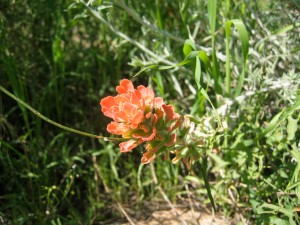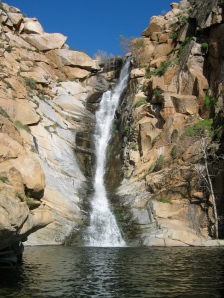I made this recipe up after reading about udon dishes online and also consulting Harold McGee’s masterpiece On Food and Cooking, which had this great tidbit on katsuoboshi:
The most remarkable preserved fish is katsuoboshi, a cornerstone of Japanese cooking, which dates from around 1700, and is made most often from one fish, the skip-jack tuna Katsuwonus pelamis. The fish’s musculature is cut away from the body in several pieces, which are gently boiled in salt water for about an hour, and their skin removed. Next, they undergo a routing of daily hot-smoking above a hardwood fire until they have fully hardened. This stage lasts 10 to 20 days. Then the pieces are inoculated with one ore more of several different molds (species of Asptergillus, Euroticum, Penicillium, sealed in a box, and allowed to ferment on their surface for about two weeks. After a day or two of sun-drying, the mold is scraped off; this molding process is repeated three to four times. At the end, after a total of three to five months, the meat has turned light brown and dense; when struck, it’s said to sound like a resonant piece of wood.
Why go to all this trouble? Because it accumulates a spectrum of flavor molecules whose breadth is approached only in the finest cured meats and cheeses. From the fish muscle itself and its enzymes come lactic acid and savory amino acids, peptides, and nucleotides; from the smoking come pungent phenolic compounds; from the boiling, smoking, and sun-drying come the roasted, meaty aromas of nitrogen- and sulfur-containing carbon rings; and from the mold’s attack on fish fat come many flowery, fruity, green notes.
Katsuoboshi is to the Japanese tradition what concentrated veal stock is to the French: a convenient flavor base for many soups and sauces. It contributes its months of flavor-making in a matter of moments in the form of fine shavings. For the basic broth called dashi, cold water is brought just to the boil with a piece of kombu seaweed, which is then removed. The katsuoboshi shavings are added, the liquid again brought to the boil, and poured off the shavings the moment they absorb enough water to fall to the bottom. The broth’s delicate flavor is spoiled by prolonged steeping or pressing the shavings.
I found the ingredients at one of my many local Japanese markets, but they may be harder to find elsewhere. Sansai means “mountain vegetables” (edible bracken and other fun things) and is sold as a mix in the market. I made this twice in the last week, adding other ingredients that I had in the fridge. The first time I made it with enoki mushrooms and the white part of the scallions, and the second time with caramelized onions, oyster mushrooms, and some komatsuna that I got from Be Wise Ranch at the farmer’s market. I had never tried komatsuna before. It’s delicious!
Although the amazing kasuoboshi makes this non-vegetarian, I bet you can make a vegetarian version which will also taste good.
Sansai udon
Dashi:
6 cups water (ish)
1 4″ square piece of kombu (dried kelp)
1 5g packet of katsuoboshi (dried bonito shavings)
Tsuyu:
1/4 – 1/2 cup utsukuchi (light soy sauce) [less is more, often]
1-2 Tbsp mirin (sweet cooking sake)
Soup
cooked udon (thick Japanese noodles)
sansai (mountain vegetable mix)
sliced green onions for garnish
nori (dried seaweed) for garnish
whatever else you want to put into the soup
Rinse kombu and put in water and bring to just under boiling (I used a lower heat, medium-ish, to help the steeping). Remove kombu before boiling, then add katsuoboshi. Bring to just under boiling and then turn heat off. Let it sit until the katsuoboshi sinks. Strain out katsuoboshi. This is your (ichiban) dashi.
Heat dashi, soy sauce, and mirin to just before boiling. This is your tsuyu. Lower heat and add udon, then add sansai (they are generally pre-cooked). Heat for a little bit, then pour into a bowl and garnish. I would say this makes 3 servings of udon, but it depends on how you like your broth/stuff ratio.
Variants:
- (with enoki and more green onions) Reserve white parts from the green onion garnish and chop finely. Heat some oil, add onions, cook until a little softer, then add enoki mushrooms and cook briefly. Add tsuyu and then proceed as above.
- (with caramelized onions, oyster mushrooms, and komatsuna) Heat oil and caramelize sliced onions. Add mushrooms and cook until they start to give up their liquid, then add broth and cook noodles. As the noodles are finishing getting heated up, add the komatsuna and wilt, then remove from heat and serve.

Sansai Udon with Enoki Mushrooms and Scallions

Sansai Udon with Oyster Mushrooms and Komatsuna






